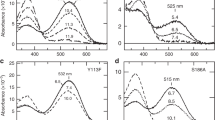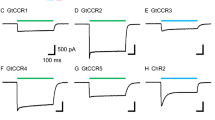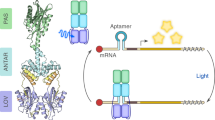Abstract
Halobacterium halobium contains a retinal–protein complex, bacteriorhodopsin, which is the only protein of the so-called purple membrane forming distinct patches within the surface membrane1,2. Bacteriorhodopsin acts as a photoreceptor molecule and is chemically similar to the visual pigment rhodopsin1,3. On illumination bacteriorhodopsin undergoes a fast cyclic photoreaction with at least four intermediates occurring after microseconds and milliseconds4–6. Various experiments indicate that bacteriorhodopsin functions as a light-driven proton pump which builds up a proton gradient across the cell membrane and is used for ATP synthesis7,8. Thus its primary function, different from that of rhodopsin in the eye, seems to be energy transformation7. Moreover, H. halobium shows light dependent motor responses, and so we supposed that bacteriorhodopsin also has a sensory function. To test this possibility we obtained action spectra for the light-induced behavioural responses from H. halobium. We found two photosystems, one of which shows that bacteriorhodopsin is involved in the light-controlled motor response.
This is a preview of subscription content, access via your institution
Access options
Subscribe to this journal
Receive 51 print issues and online access
$199.00 per year
only $3.90 per issue
Buy this article
- Purchase on Springer Link
- Instant access to full article PDF
Prices may be subject to local taxes which are calculated during checkout
Similar content being viewed by others
References
Oesterhelt, D., and Stoeckenius, W., Nature new Biol., 233, 149–152 (1971).
Blaurock, A. E., and Stoeckenius, W., Nature new Biol., 233, 152–154 (1971).
Oesterhelt, D., Meentzen, M., and Schumann, L., Eur. J. Biochem., 40, 453–463 (1973).
Kayushin, L. P., et al., Studia biophys., 42, 71–74 (1974).
Dencher, N., and Wilms, M., Biophys. Struct. Mechanism, 1, 259–271 (1975).
Stoeckenius, W., and Lozier, R. H., J. supramolec. Struct., 2, 769–774 (1974).
Oesterhelt, D., and Stoeckenius, W., Proc. natn. Acad. Sci. U.S.A., 70, 2853–2857 (1973).
Danon, A., and Stoeckenius, W., Proc. natn. Acad. Sci. U.S.A., 71, 1234–1238 (1974).
Diehn, B., Science, 181, 1009–1015 (1973).
Kropf, A., Vision Res., 7, 811–818 (1967).
Kelly, M., Norgard, S., and Liaaen-Jensen, S., Acta chem. scand., 24, 2169–2182 (1970).
Macnab, R., and Koshland, D. E., Jr, J. molec. Biol., 84, 399–406 (1974).
Racker, E., and Stoeckenius, W., J. biol. Chem., 249, 662–663 (1974).
Kayushin, L. P., and Skulachev, V. P., FEBS Lett., 39, 39–42 (1974).
Drachev, L. A., Kaulen, A. D., Ostroumov, S. A., and Skulachev, V. P., FEBS Lett., 39, 43–45 (1974).
Dundas, J. D., and Larsen, H., Archs Mikrobiol., 44, 233–239 (1962).
Author information
Authors and Affiliations
Rights and permissions
About this article
Cite this article
HILDEBRAND, E., DENCHER, N. Two photosystems controlling behavioural responses of Halobacterium halobium. Nature 257, 46–48 (1975). https://doi.org/10.1038/257046a0
Received:
Accepted:
Published:
Issue Date:
DOI: https://doi.org/10.1038/257046a0
This article is cited by
-
Sensory rhodopsin I: Receptor activation and signal relay
Journal of Bioenergetics and Biomembranes (1992)
Comments
By submitting a comment you agree to abide by our Terms and Community Guidelines. If you find something abusive or that does not comply with our terms or guidelines please flag it as inappropriate.



